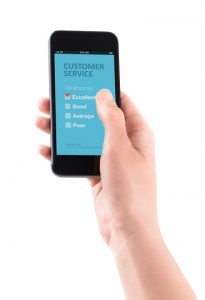
Exceptional customer service is a competitive differential. Every business seeks to provide it, but somehow, not all deliver. To be notable, customer service has to bypass good and edge closer to superlative. Why? Because customers fire companies every day because of unacceptable employee attitudes and actions.
How does the word superlative translate to action? Let’s look at some examples.
Customer Service Examples
Scenario 1: Hotel Hot Tub
- Friendly people? ✔
- Snacks and fresh fruit at front desk? ✔✔
- Hotel employee asks the customer if he wanted the jet pumps turned on in the hot tub.
In this example, the hotel employee high-hurdled over average for a surprise, story-worthy 5-star rating.
Scenario 2: Online order
- Good interface. ✔
- Easy to order. ✔✔
- Live chat availability. ✔✔✔
- Pricing error? OMG!
A phone-available customer service representative fixed the error with a confident, non-surly, genuine apology and a free gift.
Scenario 3: Restaurant
- Clean. ✔
- Food healthy and tasty. ✔✔
- How’s the __________ sandwich?” Server’s answer, “I don’t know. I’ve never tried it.” Or, “It’s okay, I guess.”
ZERO for customer service, as in, “Don’t you care enough about where you work to either taste the food, OR to ask customers if they like the __________sandwich?”
Customers will quickly and electronically spread the word about this unhelpful and unpleasant experience. YELP us out, here.
Scenario 4: Industrial purchasing agent calls in an order
- The item is out of local stock. OOPS. Lost points.
- The Customer Service Rep (CSR) calls another warehouse. ✔
- Satellite warehouse has the stock. ✔✔
Without checking with management, the CSR offers to overnight product to the customer at no cost, exceeding expectations.
Lessons Learned
While anecdotal, the lessons learned from these real-world scenarios can be summarized by these key observations:
1. The delivery of exceptional customer service varies with the setting… restaurant vs. online vs. phone, etc.
2. Customer service is often noticed by the absence of it.
3. Notably, the common denominator to a customer-retaining, customer- returning level of service is invisible: it’s the company’s culture.
4. Whatever the customer service experience—positive or negative—it can be shared in the blink of an eye!
The Common Thread

Positive experiences come from employees who care; employees who think and are proactive, rather than reactive. When employees are empowered to solve problems and deliver an exceptional customer experience because their company backs them, it’s a win-win scenario for everyone.
Today’s customers are less patient, more vocal and eternally connected to their mobile devices, making online reviews easy and potentially damaging to a business. So whether you’re B2B or B2C, customer service has to be impeccable, and employees have to go beyond routine by demonstrating a sincere interest in and appreciation of every customer they encounter.
